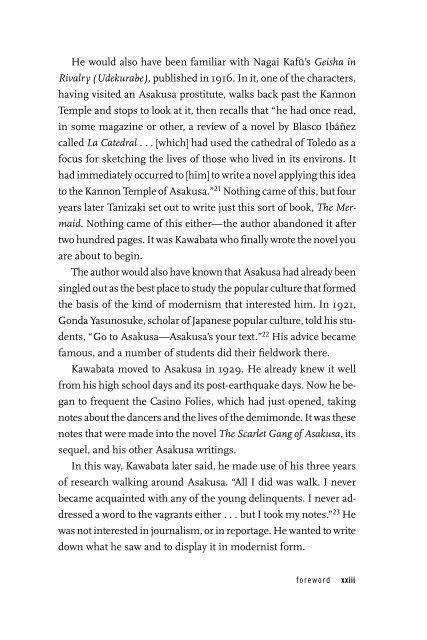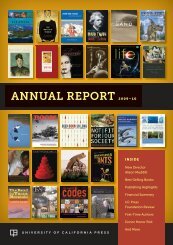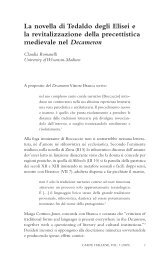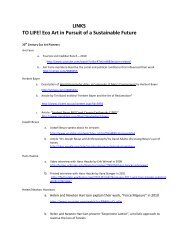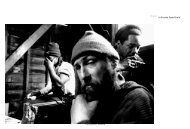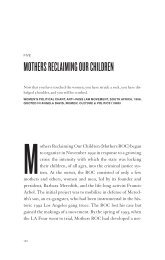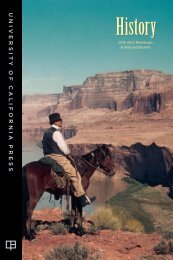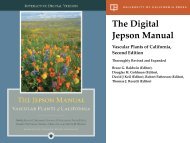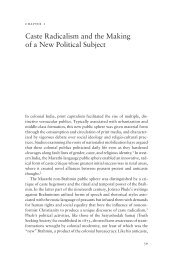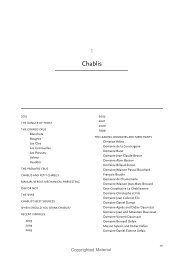Read an Excerpt (PDF) - University of California Press
Read an Excerpt (PDF) - University of California Press
Read an Excerpt (PDF) - University of California Press
Create successful ePaper yourself
Turn your PDF publications into a flip-book with our unique Google optimized e-Paper software.
He would also have been familiar with Nagai Kafv’s Geisha in<br />
Rivalry (Udekurabe), published in 1916. In it, one <strong>of</strong> the characters,<br />
having visited <strong>an</strong> Asakusa prostitute, walks back past the K<strong>an</strong>non<br />
Temple <strong>an</strong>d stops to look at it, then recalls that “he had once read,<br />
in some magazine or other, a review <strong>of</strong> a novel by Blasco Ibáñez<br />
called La Catedral ...[which] had used the cathedral <strong>of</strong> Toledo as a<br />
focus for sketching the lives <strong>of</strong> those who lived in its environs. It<br />
had immediately occurred to [him] to write a novel applying this idea<br />
to the K<strong>an</strong>non Temple <strong>of</strong> Asakusa.” 21 Nothing came <strong>of</strong> this, but four<br />
years later T<strong>an</strong>izaki set out to write just this sort <strong>of</strong> book, The Mermaid.<br />
Nothing came <strong>of</strong> this either—the author ab<strong>an</strong>doned it after<br />
two hundred pages. It was Kawabata who finally wrote the novel you<br />
are about to begin.<br />
The author would also have known that Asakusa had already been<br />
singled out as the best place to study the popular culture that formed<br />
the basis <strong>of</strong> the kind <strong>of</strong> modernism that interested him. In 1921,<br />
Gonda Yasunosuke, scholar <strong>of</strong> Jap<strong>an</strong>ese popular culture, told his students,<br />
“Go to Asakusa—Asakusa’s your text.” 22 His advice became<br />
famous, <strong>an</strong>d a number <strong>of</strong> students did their fieldwork there.<br />
Kawabata moved to Asakusa in 1929. He already knew it well<br />
from his high school days <strong>an</strong>d its post-earthquake days. Now he beg<strong>an</strong><br />
to frequent the Casino Folies, which had just opened, taking<br />
notes about the d<strong>an</strong>cers <strong>an</strong>d the lives <strong>of</strong> the demimonde. It was these<br />
notes that were made into the novel The Scarlet G<strong>an</strong>g <strong>of</strong> Asakusa, its<br />
sequel, <strong>an</strong>d his other Asakusa writings.<br />
In this way, Kawabata later said, he made use <strong>of</strong> his three years<br />
<strong>of</strong> research walking around Asakusa. “All I did was walk. I never<br />
became acquainted with <strong>an</strong>y <strong>of</strong> the young delinquents. I never addressed<br />
a word to the vagr<strong>an</strong>ts either ...but I took my notes.” 23 He<br />
was not interested in journalism, or in reportage. He w<strong>an</strong>ted to write<br />
down what he saw <strong>an</strong>d to display it in modernist form.<br />
foreword<br />
xxiii


